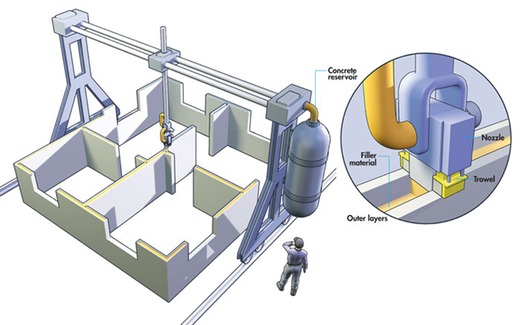14th October 2013
A 3D printing technique capable of building the shell of a 2,000 sq ft house in less than 20 hours could be just two years away from commercial use, researchers claim.
The technology was demonstrated last month at the Inside 3D Printing trade show in the US and within two years it will be used to construct entire buildings in less than a day, claimed Professor Behrokh Khoshnevis, who is leading the effort to perfect the technology at the University of Southern California’s Viterbi School of Engineering.
The robotic extrusion method, branded Contour Crafting, is similar to smaller scale 3D printers, but is capable of fabricating large-scale parts quickly with a superior surface finish.

Drawing from USC’s Center for Rapid Automated Fabrication Technologies shows how a print-head rigged to a gantry could print full-size buildings
“[Traditional construction] is wasteful, emission causing, corruption prone and the cost is always over budget,” the Iranian-born professor told conference attendees, according to ComputerWorld.com.
“What we aspire to do is create neighbourhoods at a fraction of the cost, a fraction of the time and far more safely with beautiful architectural designs.”
A contour crafting machine comprises a metal gantry frame and robotic extruding system, similar to a printhead, which emits layers of cement infused with a special hardener that allows the cement to keep its form as each successive layer is printed. The term “contour crafting” is used because materials are extruded through a nozzle, so the walls of a building can take almost any form.

Prototype print head building a three-foot-high wall at University of Southern California
Professor Khoshnevis has used the system to create 6ft-high walls in layers 6 inches deep and 4 inches wide, and he claims it can be expanded to create the entire structure of a 2,000 sq ft house, including floors, walls and roof, in less than 20 hours.
The machine currently uses the ground as a build platform but, in future the professor claims it could be designed to climb up the sides of a house as it is built one layer at a time. He has also suggested positioning the printer arms on huge rails enabling it to quickly print consecutive houses, or entire neighbourhoods, one after another.
Contour crafting could provide a cheap means of building low-income housing for people in impoverished areas of the world. Professor Khoshnevis also claims contoured structures are stronger, pointing to the ancient contoured Adobe structures in Africa and West Asia made of mud, clay and straw.

Professor Berok Khoshnevis, University of Southern California
“The reason they last is not the material, the strength comes from the geometry,” he said. “The worst structures you can use are planar [flat] walls.”
The concept of using 3D printing technology to build habitats on the moon is also being explored by the European Space Agency and Nasa, potentially using moon dust as a binding agent to erect structures cheaply without the need to transport materials through space.
The moon lacks the water necessary to extrude concrete, but Khoshnevis has devised a proposal for laser sintering moon dust to fuse together material into solid structures. He has already simulated the process on earth by sintering rock using sulphur as a binder.
Read an in-depth review of 3D printing and construction in this month’s Construction Manager






